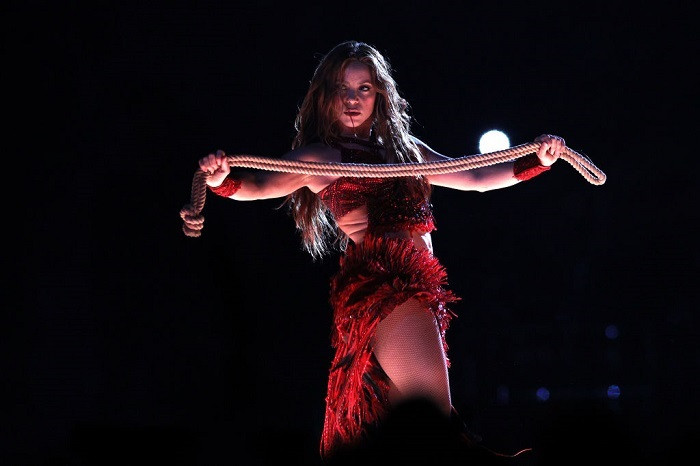Shakira, a global icon celebrated for her dynamic stage presence and distinctive voice, is more than just a pop superstar. Did you know she’s half-Lebanese? This rich heritage, meaning “full of grace” in Arabic, is deeply woven into the fabric of her artistry, particularly her captivating dance moves. While her Colombian roots are undeniable, Shakira’s performances often subtly and sometimes explicitly nod to her Lebanese ancestry, creating a mesmerizing fusion that sets her apart. Last night’s Super Bowl LIV halftime show was a vibrant example of this cultural tapestry.
 Shakira performing at the Super Bowl LIV halftime show, showcasing her dynamic dance moves.
Shakira performing at the Super Bowl LIV halftime show, showcasing her dynamic dance moves.
For those unfamiliar, Shakira’s music has long been a fascinating blend of her Colombian upbringing and her diverse ethnic background, encompassing Lebanese, Spanish, and Italian influences. This fusion isn’t new; her music video for “Ojos Así” offered an early glimpse into her Arabic musical inclinations. However, her Super Bowl performance took this exploration to a grander stage, explicitly highlighting Middle Eastern elements in a way that resonated deeply with many, as this viral tweet pointed out:
You really have to understand how huge Shakira’s performance was for the Middle Eastern community. She had belly dancing, a mijwiz and a derbeke, performed “Ojos Asi” which was one of the few Shakira songs to have Arabic in it, did a Zaghrouta, all love on the biggest stage
So, let’s delve deeper into the “Middle Eastern stuff” that enriched Shakira’s Super Bowl performance and understand how it contributes to the unique “Dance Of Shakira” we all admire.
Belly Dance: Strength, Skill, and Cultural Roots
Belly dance, often misrepresented in Western cultures as merely “sexualized dancing,” carries a far richer history and significance. This misconception contributes to the unfortunate Orientalization of Middle Eastern women and their cultural expressions. However, Shakira’s embrace of belly dance challenges these stereotypes. What’s striking about Shakira’s belly dancing is how she often performs it solo or surrounded by other women, emphasizing the communal and empowering aspects of this dance form.
Belly dance is incredibly demanding, requiring immense strength and control. It showcases the power and grace of the dancers. Think of Jennifer Lopez’s character in Hustlers, highlighting the inherent strength in women. Shakira embodies this and elevates it. Her mastery is evident in the variety of her movements, from percussive hip thrusts to the fluid motion of her torso and arms, and her remarkable ability to isolate her rib cage. She is, simply put, exceptionally skilled in this art form, making belly dance a core component of the captivating “dance of Shakira.”
Mijwiz: The Soulful Sound of Arabic Music
The mijwiz, a double-piped reed flute, might be familiar to anyone who has listened to Middle Eastern music. Sometimes referred to as a “double clarinet,” this instrument is a staple in Arabic folk music. It’s known for its complex playing technique, requiring circular breathing to produce an uninterrupted flow of melody. In Shakira’s Super Bowl performance, the distinctive sound of the mijwiz was prominent during her rope dance sequence, adding an authentic Middle Eastern flavor to her performance.
The mijwiz’s lively and rhythmic tunes are inherently danceable, evoking a sense of celebration and movement. It’s the kind of music that makes you want to “bust a move,” as comedian Maz Jobrani might say about brown people’s love for dance. The inclusion of the mijwiz underscores Shakira’s intention to celebrate her cultural heritage through her performance.
Derbeke: Ancient Rhythms in a Modern Beat
Another instrument featured in Shakira’s Super Bowl show, as highlighted in Danny Hajjar’s tweet, was the derbeke. This drum, a modern iteration of the ancient doumbek, was visible in the orchestral arrangement accompanying Shakira’s performance of “Empire,” just before she transitioned into Led Zeppelin’s “Kashmir.” The doumbek, with its goblet shape, boasts a history stretching back thousands of years across the Middle East, North Africa, South Asia, and the Mediterranean, known by various names like tombak or tonbak in Iran.
The derbeke is played by striking different parts of the drumhead with the fingers, producing a range of tones that drive the rhythm of Middle Eastern music. Its presence in Shakira’s performance provided a rhythmic foundation rooted in ancient musical traditions, seamlessly blending with the modern pop elements of her show.
Zaghrouta: A Joyful Cry of Celebration
Finally, the zaghrouta, a traditional ululation performed by women to express joy and celebration, was another powerful Middle Eastern element Shakira incorporated. Despite some misinterpretations online, even being wrongly compared to offensive gestures or animal sounds, the zaghrouta holds a significant place in Middle Eastern culture.
The zaghrouta is a common sound at Middle Eastern celebrations, from weddings to parties. Its use isn’t limited to Arabic cultures; it’s also heard at Iranian weddings and in regions with historical Muslim influence, like the Balkans. This vocal expression is a powerful symbol of communal joy and celebration. Shakira’s inclusion of the zaghrouta was a clear and resonant tribute to her Lebanese heritage, adding another layer of cultural depth to her performance.
On one of the world’s biggest stages, Shakira unapologetically celebrated her Lebanese heritage in a nation often plagued by misconceptions about the Middle East. While some may have focused on superficial aspects of the performance, or even filed FCC complaints about “indecency,” it’s crucial to recognize the cultural significance and artistic brilliance of Shakira’s choices. She delivered a performance that was not only electrifying but also deeply meaningful.
In the spirit of M.I.A.’s defiant stance during her own Super Bowl moment, Shakira’s performance was a triumph. She not only “did the damn thing” musically but also culturally, enriching the global understanding of Middle Eastern traditions through the power of dance and music.
You can watch the full Super Bowl Halftime Show here.
